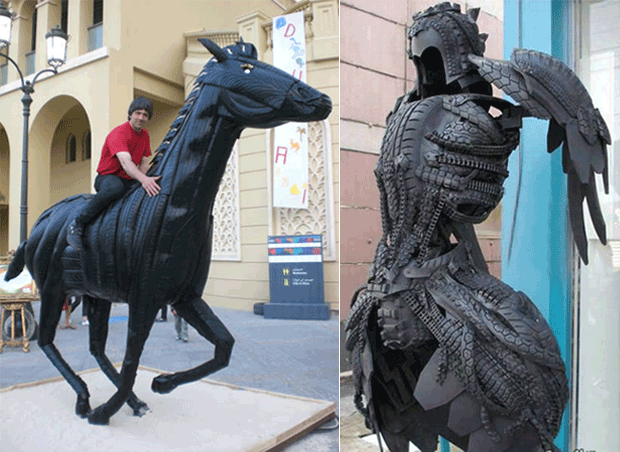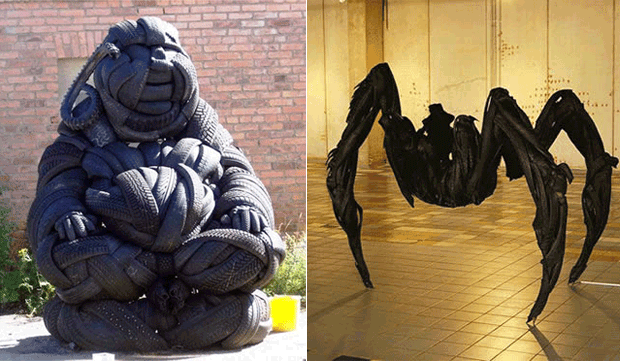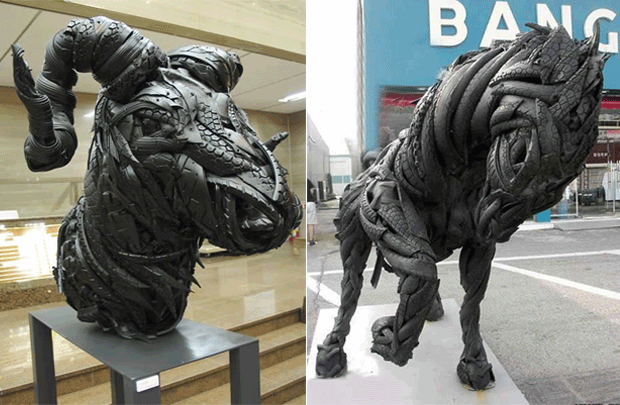|
Black beasts were in abundance at the “Korean Eye:
Fantastic Ordinary” exhibition, which came to Seoul Museum of Art’s
Gyeonghui Palace Annex early this month, after being shown at London’s
Saatchi Gallery and Singapore’s Arts House earlier this year.
There was a frighteningly intense energy coming from the tail of the
shark hanging from the ceiling in the main gallery, and from the
condensed muscles of the jaguar about to jump up nearby. Surprisingly,
the beasts are made of used tires.
These striking sculptures are by Ji Yong-ho, 32, one of the 12 artists
participating in the Korean Eye 2010 exhibit. Korean Eye promotes local
artists by exhibiting their work around the globe. The show has now
moved to the Korea Foundation Cultural Center, where “Jaguar” is among
the works on display.
A closer look at the beast, which seems to be roaring fiercely, shows
that its black eyes are unexpectedly quiet and melancholy.
|
|

|
|
“The solitude and sadness captured in a powerful exterior is a
consistent theme in my work,” Ji said. “Rather than conveying verbal
messages, my works depict a universal emotion that is hard to express in
words.”
Like his sculptures, the artist himself has a tough look and muscular
arms from cutting and assembling tires, but his eyes have a calm and
serious look.
Ji said his work is inspired by the sad eyes of animal trophies. Human
beings hang the trophies proudly on their walls, as if to proclaim that
they have conquered a fearful beast, Ji said. But he wonders whether the
beasts haven’t been sacrificed at the altar of human greed. His works
seem to ask which is the most fearful.
But Ji said the sculptures in his “Mutant” series are not necessarily
about the confrontation between human and animals. Rather, he says his
works speak for the fragile and lonely men who have to struggle to
survive in the jungle of contemporary society, pretending to be strong.
|
|

|
|
“What I really want to talk about through my work is humans,” he said.
“I’ve been expressing that with animals and now I’ve moved to half-man,
half-animal figures. Someday I’ll be able to make human sculptures as
well.”
Ji’s sculptures attracted a lot of attention at the Korean Eye show at
the Saatchi Gallery, where the exhibit opened in July. Perhaps it is
because the sculptures are visually strong but not overly conceptual,
and are made of such unusual material.
They gained particular notice from Tim Miller, chairman of Standard
Chartered Korea, which has supported the Korean Eye project, and
Francesco Baragiola Mordini, who is in charge of international
publications at Skira, a well-known Italian publishing company that
published a book about Korean artists this year.
The works also garnered an enthusiastic response from viewers attending
the Arco Art Fair Spain early this year, as well as at the artist’s
shared exhibition with Yi Han-kwon at Hong Kong’s Causeway Bay Times
Square this July and August.
Despite the sculptures’ seeming lack of nationality, a few Western
critics have found the Eastern elements in his works.
“When I was studying at New York, my friends saw my work and talked
about Asian circulation theory,” Ji said. “The tire, an inanimate
object, originally comes from live rubber trees. Then it becomes waste
and then it becomes a live organism after I’ve worked with it.”
To make the sculptures, Ji said he first makes a stainless steel
skeleton and adds shredded used tires to the frame. During this process,
a new idea may pop up, or an accident may take the piece in a new
direction - improvising, which Ji said he appreciates.
He said he uses all sorts of tires - from tractors to bicycles. He
chooses different tires depending on the forms and characteristics he
wants to express. For “Shark,” a work with a strong sense of speed, Ji
used tires from motorcycles and race cars.
Still, Ji said he is not too obsessed with the material itself.
“I use wasted tires only because it supports my concepts the best,” he
said. “It is the best material to catch the powerful, dynamic, tough but
elastic side of muscles. New tires don’t really work so I always use
used tires.
“But if I’m trying a new piece with a different concept, I change the
material according to the piece. For now, I’m planning to work on new
concepts while continuing my current work. In fact, I have already been
trying new materials for the new concepts.”
Ji is also considering mixing sculptures and painting. He said he loves
sculpting but is also fascinated by the color he sees in paintings. He
showed one of these works at a two-person exhibition with painter Kim
Nam-pyo in September at the Gana Art Gallery.
Ji majored in sculpture at Hongik University and received his master’s
in fine arts from New York University. Since then, he has become one of
the most popular Korean artists outside of Korea. He sold a version of
Shark in 2007 for $145,000 at an auction organized by New York-based
Phillips de Pury & Company and saw all of his works sell out at his solo
show at Taiwan’s Soka Art Center in 2009.
But this young, successful artist also has his own concerns.
“In Korea, when an artist’s works start to sell well in commercial
galleries, nonprofit museums become reluctant to include the artist in
their shows,” Ji said.
To be recognized by both entities in Korea, he says artists should first
participate in residency programs run by public museums, then have
larger exhibitions at nonprofit spaces, and finally put their work in
commercial galleries.
“But I did not go down this path, because I became known at commercial
galleries while I was studying abroad,” he said. “Outside Korea, museums
and commercial galleries are well connected and they value the
coexistence of artistic quality and commercial appeal. I regret that
people here think the two must be inversely proportional. However, since
it is museums that organize many of the high quality exhibitions, I
would like to have a solo show in a Korean art museum someday.”
But Ji also pointed out there is an unwritten rule in Korea that solo
exhibitions in museums are for artists over 40, or for those who are at
least 35.
For now, he is turning his attention to Europe with an exhibition with
Kim Nam-pyo in Amsterdam next year. Ji also said he is looking to hold
solo shows in France or Germany.
*Korean Eye runs until Nov. 30 at the Korea Foundation Cultural Center.
Go to City Hall Station, line No. 2, exit 9. Admission is free. Hours
are 10 a.m. to 6 p.m. Monday through Saturday.
|
|
 |